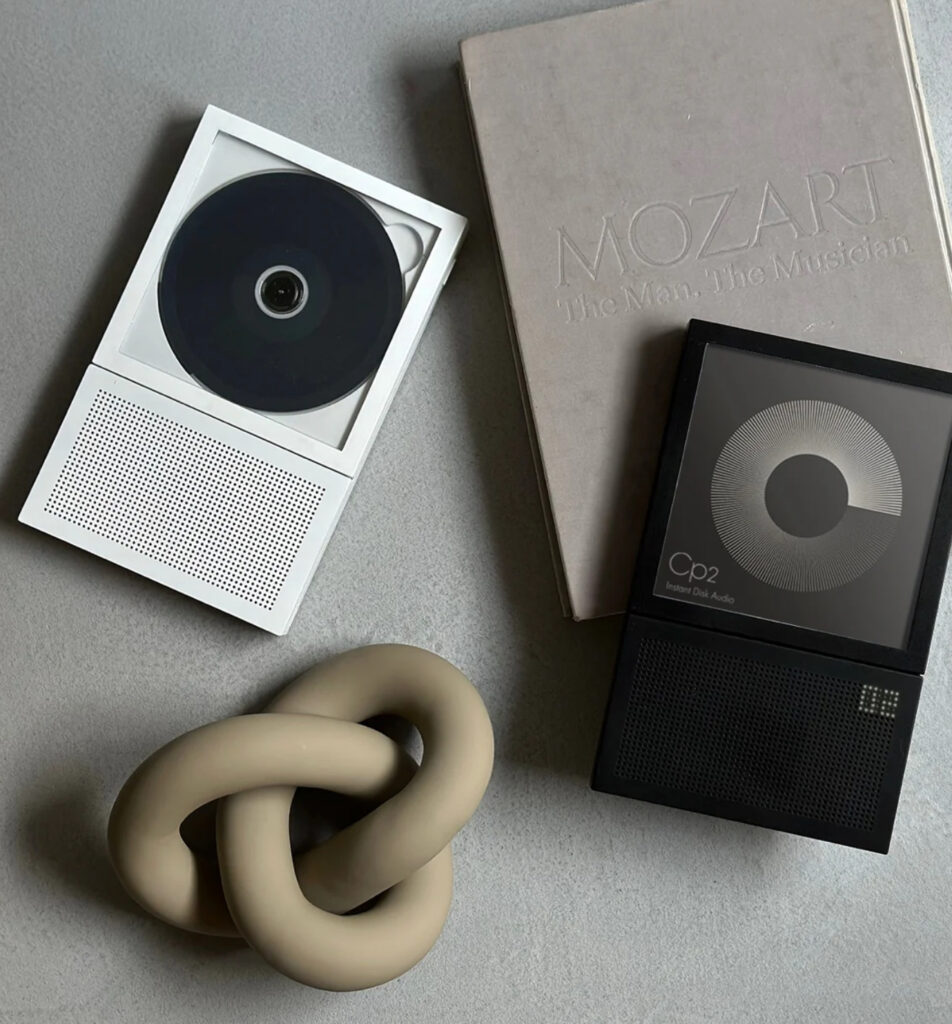In the present digital era—where every song lives on cloud servers and algorithms often determine what we hear—it might seem counterintuitive to invest in a physical object to enjoy music. But that’s exactly what the Elevate Stand asks us to do. Not in opposition to modernity, but in elegant harmony with it. This sleek new stand is not just an accessory; it is a design-forward tribute to physical media, musical intimacy, and the evocative power of album art. It frames the CD not as obsolete, but as an aesthetic statement—something you look at while you listen, and something you can build a room, a moment, or a mood around.
This editorial unpacks the cultural significance of the Elevate Stand and the portable media player it supports. At the intersection of minimalism, nostalgia, and new-generation analog living, the Elevate Stand is more than furniture or functional support—it’s a platform that gives weight back to the music object, reconnecting listening with presence.
A Deliberate Pause in a World of Scrolls
The Elevate Stand exists because the act of listening to music has been fragmented. What was once tactile and ritualized—unwrapping a jewel case, sliding the disc into a player, flipping through liner notes—has become instant and invisible. With streaming platforms, we experience music as data, often passively, while doing something else. We let songs pass through us, rarely anchored by physical interaction.
But the Elevate Stand restores intention to the listening experience. By spotlighting the CD jacket alongside the music it represents, it reminds us that albums are both sonic and visual narratives. The display format compels you to sit, see, and hear. It’s a system designed not just for playback, but for pause.
Placed on a table, mounted on a wall, or even carried around, the stand invites you to treat your favorite albums not as background noise, but as artwork deserving of curation. The CD becomes a part of your interior life—your room, your identity—not just your playlist.
Design Language That Speaks Softly
At a glance, the Elevate Stand is strikingly modern in its restraint. Its minimalist build reflects contemporary aesthetics: all clean lines, monochrome finishes, and balanced proportions. But its simplicity belies a deeper philosophical impulse—by reducing excess, the design leaves space for focus. This is not merely about style, but about shaping experience.
Its compact architecture accommodates a CD player with an integrated speaker, a display window for album art, and rechargeable battery support. And while the stand has a deliberate stillness about it, the built-in speaker and portability allow for dynamic, on-the-go use. You can hang it on a studio wall, place it on your kitchen shelf, or carry it to a friend’s apartment—wherever it goes, it brings the ritual with it.
The visual frame evokes something between a pedestal and a shadowbox—an art installation built for everyday use. It doesn’t scream for attention, but rather rewards it. It’s as suited to a Brooklyn loft as it is to a Kyoto flat. It belongs to no era, and in that way, belongs to all of them.
The Audiovisual Thread: Album Covers as Cultural Memory
Perhaps the most distinctive feature of the Elevate Stand system is its CD jacket display pocket. This detail seems minor, but it’s radically thoughtful. It transforms the music-listening experience into a multi-sensory event. Here, sound and image operate in tandem. You hear the music, but you also absorb its visual counterpart. You see the typography, the palette, the photo choices, the art direction that once accompanied every serious album release.
In the age of tiny thumbnails on streaming apps, this is a revelation. Consider how often a generation of listeners discovered music through visual association—by flipping through CD racks, noticing a striking cover, and taking a risk. That was a visual literacy, and the Elevate Stand helps reawaken it.
It’s not just about the music you play—it’s about the album you display. Maybe you’ve got Björk’s Homogenic rotating next to Massive Attack’s Mezzanine, or a rotation of Kanye West, Lauryn Hill, and Portishead. Whatever you choose, your selections become aesthetic declarations. They form a curated exhibit—one built not for mass viewership, but personal ambiance.
A Post-Digital Revival: Nostalgia Meets Function
The resurgence of physical media isn’t just about nostalgia—it’s also about sovereignty. As streaming becomes increasingly corporatized, and algorithmic curation flattens discovery, listeners are pushing back with analog formats that encourage autonomy and depth. Vinyl is booming. Cassette labels are thriving. CDs, too, are quietly finding their way back into cultural favor—not least because they offer high-fidelity sound in a compact, portable form.
But CDs need infrastructure to feel relevant again, and that’s where the Elevate Stand comes in. It supplies the context—a physical framework that reactivates the format’s potential. It’s designed not for tech fetishists or music snobs, but for anyone who wants to form a deeper relationship with their music.
With its built-in speaker and rechargeable battery, the CD player doubles as a portable music system. No need for high-end stereo gear or complicated setups. You just load a disc, press play, and watch the cover sit quietly beside the music it contains. It’s a gentle inversion of the modern impulse to maximize, digitize, and upgrade. Instead, this is about simplifying, beautifying, and reconnecting.
Display as Dialogue: Music as Interior Language
Home décor has evolved to embrace hybrid objects—things that are at once functional and symbolic. Coffee table books are as much about showing who you are as reading. Art prints and vintage furniture say as much about your values as your taste. The Elevate Stand joins this category as a new kind of design statement: it’s music-as-object, and music-as-self.
In many ways, the stand repositions music within domestic life. Where once hi-fi towers dominated living rooms in the 1970s, the Elevate is far subtler. It invites its user to become a quiet curator of their space, a designer of mood. Want to create a moody dinner atmosphere? Display a jazz album with noirish cover art. Hosting a summer get-together? Let a bright, sunny CD case set the tone.
The stand doesn’t merely hold your player—it holds your perspective. And that’s part of what makes it quietly radical. It transforms the passive experience of background listening into a visual and emotional exchange.
Technological Restraint as Artistic Gesture
In the context of modern tech, the Elevate Stand is almost defiant. No screens, no subscriptions, no swipes—just a tangible object performing a simple task with elegance. There’s beauty in that restraint.
Unlike “smart” speakers that harvest data or music apps designed to trap you in feedback loops, the Elevate Stand provides nothing but sound, image, and space. It’s not about choice paralysis—it’s about choosing one album at a time, letting it breathe, and treating it like a small performance.
There’s also the social aspect: in a group setting, this player offers a centerpiece. Unlike Bluetooth speakers hidden behind furniture, this device sits in plain sight, radiating style and intention. It tells your guests what kind of music you value. It invites them to notice. In this way, the Elevate isn’t just a design object—it’s a conversation starter.
Future of Playback: The Intimate Renaissance
As we drift further into digital immersion, we also drift toward digital fatigue. The Elevate Stand speaks to a new countercurrent—one that prioritizes intimate, analog, art-forward experiences. Whether you’re a diehard CD collector or someone who just wants to enjoy music more mindfully, the Elevate Stand turns playback into presence.
There’s something deeply satisfying about re-engaging with media physically. To hold a disc. To admire its artwork. To hear the faint click of the tray closing, the whir of the laser. It’s tactile, sensory, and strangely grounding.
And it’s not trying to compete with streaming. It’s offering something else entirely: an experience you don’t scroll past. One that sits with you, becomes part of your space, and lingers longer in memory because it was slow, curated, and real.
A Platform for Listening, Literally and Figuratively
The Elevate Stand isn’t just a tech accessory or a nod to retro sensibilities. It’s a cultural object designed for now—when we’re yearning for anchors, rituals, and physicality in an increasingly intangible world. It re-centers music as something worth displaying, not just consuming. It reminds us that cover art matters, that sonic detail deserves our attention, and that design can influence not just how we hear music, but how we feel it.
At a time when many products promise to streamline and shrink our experiences, the Elevate Stand expands them. By giving form to sound and visibility to albums, it makes the act of listening feel significant again. Whether mounted on a wall or nestled into a bookshelf, it becomes part of your living narrative—proof that music, when treated with care and context, becomes more than just entertainment. It becomes presence. Aesthetic. Memory. And meaning.
No comments yet.









